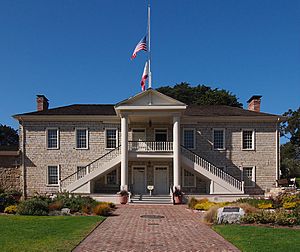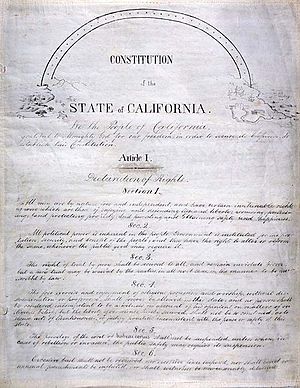California Constitutional Conventions facts for kids
The California Constitutional Conventions were two separate constitutional conventions that took place in California during the nineteenth century which led to the creation of the modern Constitution of California. The first, known as the Monterey Convention, held in September and October 1849 in advance of California attaining U.S. statehood the following year, adopted the state's original constitution. This document maintains jurisdiction along with the current constitution which was ratified on May 7, 1879, following the Sacramento Convention. Article 3 Section 2 of the current Constitution references the original boundaries as stated in the 1849 Constitution at Article 7. The result of Progressive mistrust of elected officials, this later constitution took a full year to finalize (March 1878 to March 1879) and has been described as "the perfect example of what a constitution ought not to be". Multiple calls for a third state constitutional convention have been raised during the past quarter-century, but none has thus far gained widespread political momentum.
Monterey Convention of 1849

The Monterey Convention of 1849 was the first California Constitutional Convention to take place. Bvt. Brig. Gen. Bennett C. Riley, ex officio Governor of California, issued a proclamation on June 3, 1849 calling for a convention and a special election on August 1 where delegates to the convention would be elected.
The memorial presenting the proposed constitution to Congress claimed it banned slavery not because of anti-slavery sentiment, but just unanimous agreement (including convention delegates originally from slave states) that California's climate and soil were not suitable for slave labor. It also described the proposed eastern boundary as a compromise between those who wished to include all of former Mexican Alta California (including today's Nevada, Utah, and Arizona) and a committee-proposed eastern boundary at 116° (including the western half of Nevada but excluding the Lower Colorado River Valley and Imperial Valley), and denied having considered north–south division at the Missouri Compromise Line (south of Carmel and Fresno), saying Southern Californians had no interest in division.
Sacramento Convention of 1878–79
The Sacramento Convention of 1878–79 amended and ratified the original 1849 constitution. It took place in Sacramento, California from March 1878 to March 1879.
The Convention was composed of 152 delegates. A series of districts were apportioned 88 delegates. Some of the districts were composed of a single county, some composed of several counties, and others operated as floterial districts. The electorate of the State at-large elected 32 delegates. Each of the four Congressional district elected 8 delegates.
The new California Constitution produced by the Convention was voted for on May 7, 1879, and adopted by a vote of 77,959 to 67,134.
Future Conventions
Present language in the Constitution of California: "The Legislature by rollcall vote entered in the journal, two-thirds of the membership of each house concurring, may submit at a general election the question whether to call a convention to revise the Constitution. If the majority vote yes on that question, within 6 months the Legislature shall provide for the convention. Delegates to a constitutional convention shall be voters elected from districts as nearly equal in population as may be practicable." (ARTICLE XVIII AMENDING AND REVISING THE CONSTITUTION SEC. 2)
Two proposition petitions circulating in 2010, 09-0066 Citizens' Constitutional Convention Act and 09-0067 The Call for a Citizens' Limited Constitutional Convention, when read together would have amended the mechanism of calling a constitutional convention. Specifically the Citizens' Constitutional Convention Act "shall specify a fair method for selecting or electing citizens to be delegates to a constitutional convention". And the Call for a Citizens' Limited Constitutional Convention would have three types of delegates: Assembly district, County, and Tribal. There shall be 240 delegates from the Assembly districts. Three delegates elected by, and among, a randomly selected pool of 50 eligible persons from each Assembly district. There shall be one County delegate for every whole fraction of 175,000 persons residing in each County, provided that there shall be at least one County delegate for each County. According to the 2010 census, there would have been 217 County delegates. One delegate selected by each of the federally recognized tribes. A total of 461 delegates, each having one vote. Of which 231 would have been required to propose amendments to the electorate, but broad consensus was highly encouraged.
See also
 In Spanish: Convenciones constitucionales en el estado de California para niños
In Spanish: Convenciones constitucionales en el estado de California para niños


